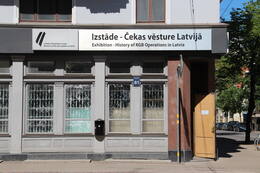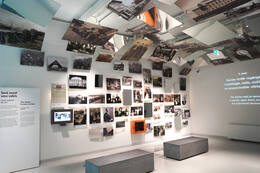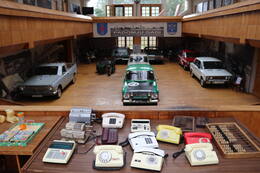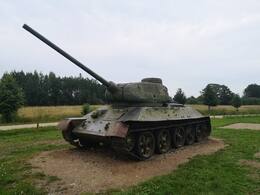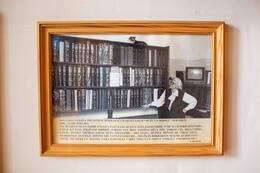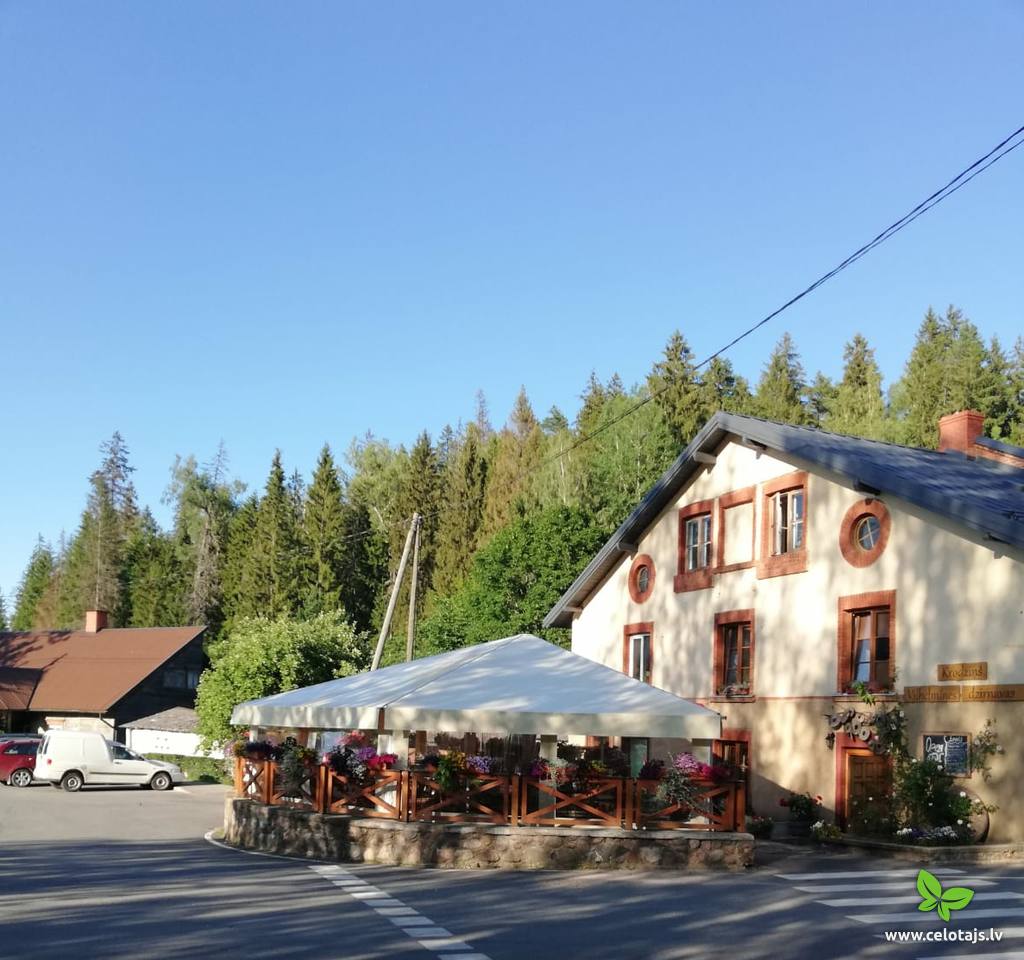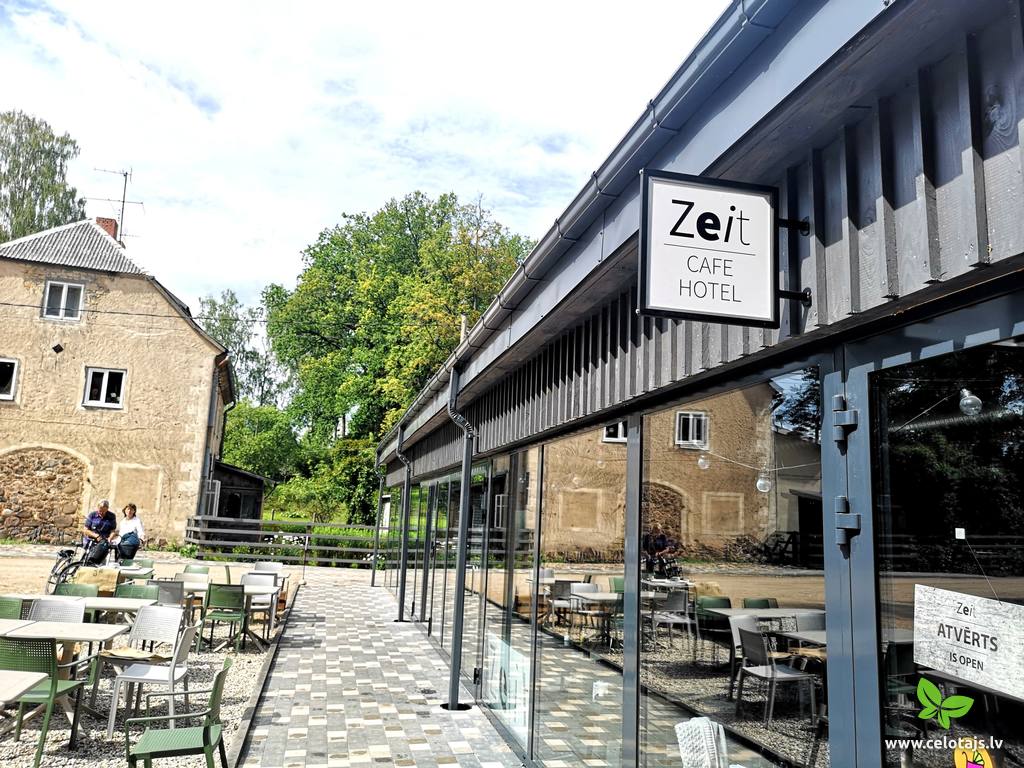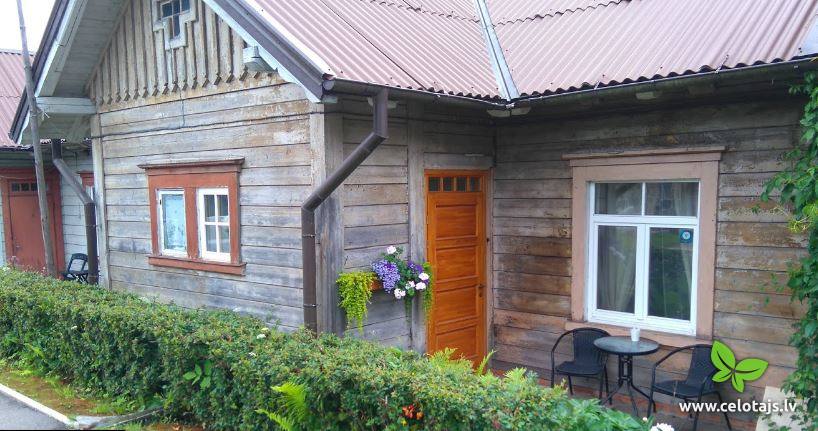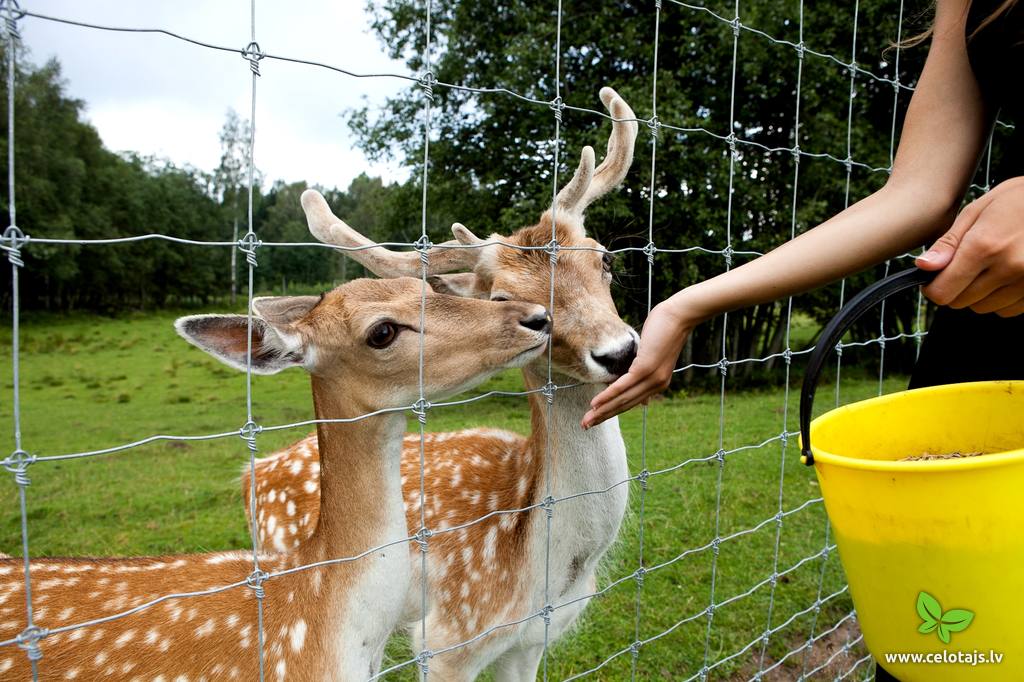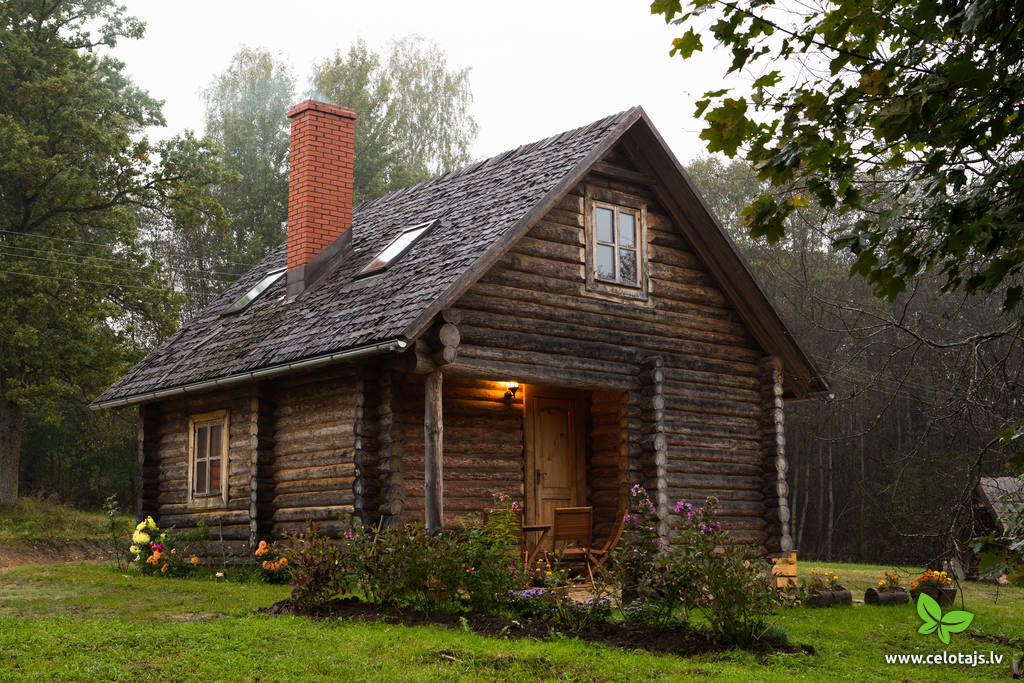The heritage of Soviet Occupation in North Vidzeme and South Estonia
Day 1.
190 km
Rīga–Aizkraukle–Sigulda–More–Līgatne
Practical info
- Driving distance: 190 km
- Due to distances and time, 3–4 of the listed sights can be visited on this day.
- Tickets for the KGB Building tour in Rīga can be bought in advance. Excursion times and tickets www.bezrindas.lv. More information: +371 27875692. Not recommended for children under 12.
- Opening times for the Museum of the Occupation of Latvia okupacijasmuzejs.lv.
- The tour can be prolonged by spending a day in Rīga to visit military heritage sites such as Bother’s Cemetery and the Memorial of Žanis Lipke.
- The Museum of Battles in More is open in the summer season from 1 May to 30 October, in the winter season visits should be booked in advance.
- Visit Museum of Melānija Vanaga by advance booking only +371 29445480.
- Rīga tourist information www.liveriga.com
Sights
Exhibition in the KGB Building "History of KGB Operations in Latvia"
The former USSR State Security Committee (commonly known as Cheka) building is open for visitors. Here chekists imprisoned, interrogated and murdered Latvian citizens who were considered opponents by the occupation regime. There is also an exhibit from the Latvian Occupation Museum on the activities of Cheka in Latvia. Guided tours of the prison cells, corridors, basement and courtyard are available. The house was built in 1911 and it is one of the most beautiful buildings in Riga. Called the ‘Corner House’ by the people, it was the scariest symbol of the Soviet occupation regime in Latvia, and also one of the pillars of power of the USSR. Cheka operated from the Corner House during the occupation from 1940 to 1941 and then again from 1945 to 1991. Tens of thousands of Latvians were affected by direct political persecution. The fight against enemies of Soviet rule continued also after World War II. Cheka’s approach towards its operation slightly changed after Stalin’s death. Physical torture was replaced by psychological terror. The majority of Cheka agents were Latvians (52%). Russians were the second largest group – 23.7%. 60.3% of the agents were not members of the Communist Party. 26.9% of the agents had higher education. The system was designed in a way to involve local people and thus have greater control over the society. Staff documents and service records are located in Russia. And these materials have not been made available to Latvian authorities and researchers.
Museum of the Occupation of Latvia
The museum exhibits the history of Latvia from 1940 to 1991, under the occupation of Nazi Germany and the Soviet Union. ‘House of the Future’ is a reconstruction and expansion project of the Occupation Museum designed by the well-known American Latvian architect Gunārs Birkerts as well as the new exhibit of the museum. The exhibit ‘History of Cheka in Latvia’ was created by the Occupation Museum and it is located in the ‘Corner House’, which is the former USSR State Security Committee (KGB) building. Latvian Occupation Museum was founded in 1993. It tells the long-hidden story of the fate of the Latvian state, nation and land under the occupation of two foreign totalitarian powers from 1940 to 1991. At the end of 2020 the museum had more than 70,000 different historical items (documents, photographs, written, oral and material evidence, objects and memorabilia). Museum specialists have recorded more than 2,400 video testimonials, making it one of the largest collections on occupation in Europe. The events that unfolded in Latvia, Lithuania and Estonia clearly show us what the nations had to endure under the two totalitarian regimes.
“Soviet Years” Exhibition at Aizkraukle Museum of History and Art
In November 2018, to celebrate the centenary of Latvia, the “Soviet Years” exhibition was opened at Aizkraukle Museum of History and Art – the largest exhibition in the Baltic states dedicated to the cultural and historical heritage of the 1950s–1980s. The exhibition is spread over three floors in an area of 1,060 m2. It reflects Soviet life in its multiple facets: everyday life, work and leisure, education and culture. Soviet-era cars are on display on the ground floor.
A separate library – the Red Corner has been set up. A wide-ranging exhibition invites visitors to explore everyday life and apartment interiors during the Soviet era – furniture and household items, tableware, textiles and electrical appliances.
Other exhibition spaces are dedicated to emigration, Soviet repressions, everyday life, medicine, state structures, tourism and sport, childhood and education. Soviet military paraphernalia and uniforms are also on display among various exhibits.
Sigulda
Exploring of Sigulda can be started with a visit to Sigulda castle ruins. The construction of the castle was begun by the Knights of the Sword Order in 1207, but in 1236 it was rebuilt for the needs of the Livonian Order. Sigulda castle suffered much from the wars in the second half of the 16th century and in the beginning of 17th century. During the Northern War, it is burned down and is no more restored. Today south-western building of the convent and the tower of the main gate, behind which is the inner forefront of the castle with open air stage, which offers impressive views over the Gauja valley. Currently the reconstruction of castle ruins is in progress. Construction of New castle (owner - Prince Kropotkin) in the South of the Sigulda took place from the 1878 until 1881. From 1923 - 1940 the building was the Palace of Writers, but during the Soviet years - Cardiology sanatorium. Since 2003 Sigulda district council is located there. The manor complex includes wooden house (middle of 19th century), which was Kropotkin's family home, barn (turn of the 18th - 19th century), gardener's house (19th century) and a stone fencing (19th century.) If we make our way from New Castle in a north-eastern direction, after almost 2 km we will reach Vejupite ravine. There you can see the shallow (3.6 m) but high (6.1 m) in Peter's Cave and deep Pucu ravine with Krauklupite. At the conjunction of ravines of both streams rises a Satezele hill fort (plateau 90 x 75 m), where in the beginning of 13th century was the oak castle of Liv land chief (eldest) - Dabrelis. Near can be found Krauklu gorge - ravine of Vejupite left bank, with 11 m high sandstone walls and 5.2 m deep Krauklu cave. At the conjunction of Vejupite ravine and Gauja valley columns Paradise (Gleznotaju) Hill - a very picturesque place, painted and photographed since old times! The Paradise Hill can be reached with a electric vehicle. In the west part of Sigulda is located Ferris wheel (works during the summer) and Air cableway (streetcar) - the only this type of vehicle in Baltics (built in the 1969). Its self-supporting cable extends in 1060 m length and without any support joins the Gauja River valley banks between Sigulda and Krimulda ~ 40 m above Gauja River. Here you can enjoy excellent views! In the south-western part of Sigulda one can walk to mighty Beites precipice, which is split by the deep ravine of stream. On the west side of the ravine lies Keizarskats, which is located ~ 67 m above the Gauja level and offers good views of Krimulda and Turaida castle. Sight place was arranged here already in the 1862 when Russian Tsar Alexander II visited Sigulda. In the eastern part of the ravine wooden Keizarkrēsls (Emperor Stool) is located.
Museum of Battles in More
The museum is located in More, on the side of the V319 motorway. It is dedicated to the Battles of More between the Red Army and the Latvian Legion of the German Army in the autumn of 1944. The exhibit includes a mock-up of the battlefield, weapons, awards, soldiers’ uniforms and military equipment. The Battles of More Museum and Memorial Park was established by former soldiers of the Latvian Legion who participated in the Battles of More. The memorial park features trenches, dugouts and battlefields. The battles in the More area were only part of a large-scale operation of the Red Army Baltic Offensive involving a total of 900,000 soldiers and large numbers of military equipment units. A part of the German Army fortification system where Latvian legionnaires prevented the Red Army’s attempt to break out to Riga was located in the vicinity of More. This allowed the German Army to withdraw its forces from Estonia and avoid defeat. Red Army leaders expected the enemy’s resistance near More to be short-lived and stubbornly continued its unprepared and uncoordinated attacks, suffering heavy losses. Local advantages and the combat capabilities of the Latvian legionnaires played a significant role in the subsequent course of the war. More is home to the Latvian Legionnaires’ Brothers’ Cemetery and a Red Army Soldiers’ Cemetery.
Museum of Melānija Vanaga and Siberian dugout
The Melānija Vanaga Museum is located in the Amata village school in Cēsis municipality. The museum showcases materials about the life, literary activity, family and destiny of writer and cultural historian Melānija Vanaga: video content about Siberia and the deported Latvians living there and a Siberian dugout taking its visitors on a trip to the writer’s place of deportation in Tyukhtetsky district, Krasnoyarsk region. The appearance and layout of the dugout form a realistic idea of life away from home. The dugout features unique historical objects brought there from the Tyukhtet Museum: a birch-bark dish known as ‘tuyesok’, a clay mug known as ‘krynka’ and a kerosene lamp. The museum features video interviews with politically repressed people from the municipality and 18 characters from Melānija Vanaga’s book Suddenly, a Criminal: Sixteen Years in Siberia. The museum’s virtual exhibition ‘BE YOURSELF!’ (http://esipats.lv) shows the experiences of five deported children and their parents who were wrongly accused by the Soviet authorities of ‘betrayal of the motherland’.
Places to eat
Safari park “More” in More village
This is a breeding farm for wild animals. On 170 hectares, the family breeds European elks, fallow deer and white elks (some 400 head in all), as well as wild boar. A tour will allow you to look at the animals up close. You can taste venison foods such as shish-kabob and goulash, and you can purchase dried venison, salami and canned sautéed meats.
Cafe “Vilhelmīne Mill” in Līgatne
The saloon is in the historical centre of Līgatne, alongside a pond, and in a building that was once home to the first Līgatne paper factory.
Latvian cuisine: Vidzeme stroganoff, grilled Kolka herring, grilled pork, Amata trout, potato pancakes with cream, pancakes with jam, beer, kvass.
Special foods: A special dessert.
Hotel “Zeit” in Līgatne
Modern hotel with 9 rooms in Līgatne. Each room has a different story and room image. There are rooms such as "Glamor Room", "Worker's Room", "Dreamer Room", "Gardener's Room", "Her and His Room", "Gambler's Room", "Avanturist Room" and "Writer's Room". There is also a café and rooms for seminars available in hotel.
In Līgatne visitligatne.lv
In Sigulda tourism.sigulda.lv
Places to stay
Hotel “Zeit” in Līgatne
Modern hotel with 9 rooms in Līgatne. Each room has a different story and room image. There are rooms such as "Glamor Room", "Worker's Room", "Dreamer Room", "Gardener's Room", "Her and His Room", "Gambler's Room", "Avanturist Room" and "Writer's Room". There is also a café and rooms for seminars available in hotel.
Guest house “Vilhelmīne apartments” in Līgatne
Offers overnight stay in Līgatne's historic center, there are 2 well-equipped 4-bed rooms with amenities. Provides their guests with full-service meals and information on recreational facilities in Līgatne. Offers bike rental.
Guesthouse “More” in More village
A guesthouse in the unique environment of a deer garden. The More safari park is ideal for those who wish to forget the speed of the city and spend time in a lovely environment with wild animals at arm’s reach. You can watch various types of deer and boar and feed them by hand. You can also enjoy exclusive dishes made with wild game, as well as with the treasures of Latvia’s forests and countryside.
Cottage “Jaunlīdumnieki” near Mālpils village
The holiday house "Jaunlīdumnieki" is located on the steep bank of the Suda River, with beautiful views of the river. The proximity of the river allows you to enjoy a variety of entertainment in the vicinity of the water - swimming in a well-equipped swimming place, fishing, boat rental - kayaks, canoes, SUP board.
A living room with a fireplace and a kitchen corner is on the first floor of the holiday home, on the 2nd floor there is a bedroom with a comfortable double bed and 2 pull-out sofas. There is also a sauna with an electric oven in the house, a sauna ritual with an experienced person is offered. There are 2 separate rooms for a toilet and a shower.
The outdoor area has a pleasant garden corner with garden furniture, where you can dine, sunbath or just relax on your own.
There are several interesting sights nearby - Malpils Manor, Mālpils Dairy, Skulmek Homes and Nature trail along Mergupi and a cycle route (36 km), which presents the most popular sights of Malpils region.
In Līgatne visitligatne.lv




